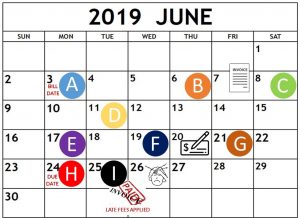If you are responsible for managing expenses for your business or organization, you already know that energy costs gobble up a large piece of your budgetary pie. Whether you have one business location or many, every finance manager and accounts payable person should take a special interest in your organization’s energy bills.
3 Ways to Save Money on Energy Bills
1. Know Who Gets the Bill First
When it comes to your energy bill, its first stop can make a big difference in long term costs. Who is the first person to receive it? Does it take a day or two to get out of your mailroom? Is it delivered to the desk of your facilities manager who is too busy to make opening mail a priority? Does it sit in the company president’s in-basket while she’s traveling? Does Accounts Payable receive it, stamp it with a received date and circulate it through the organization for various approvals without keeping tabs on it? If so, you are tempting fate, and your energy bills will cost more than they should.
Not all energy providers are the same, but most offer a short timeline between billing date and due date. Unlike other bills, you rarely if ever have 30 days to pay. In some cases the date of your bill is the same as the meter-reading date. In that case, the clock began ticking before the bill left the utility provider’s mail room.
In the infographic on this page, we assumed 21 days between billing and due date, but actual timeframes are not always this leisurely. Cost Control Associates did a study for one client and discovered that there was an average of 12 days between the receipt of the energy bill and the date it was due. The company had 700 utility accounts, so you can imagine how the late fees added up. By outsourcing its processing and payment of energy bills, the client eliminated the danger of late fees, gained greater control over their usage and payment data, and saved money on energy bills.
Late fees are one thing, but service shut-offs can be catastrophic for businesses that depend on energy to keep operations underway. While residential customers have certain protections, businesses do not. An unhappy provider can stop your service and pull out the meter. Even after you resolve the payments, you may be required to pay a reconnection fee as well as a deposit to cover 1-2 months of your average bill.
To save money on energy bills, know when your energy bills arrive and when they are due. Make sure they go directly to the right person. Be sure that person has a back-up in case of absence. He or she should take responsibility for shepherding the bill anywhere it needs to go for approvals in order to get that check cut and out the door ASAP!
If your organization receives too many energy bills to keep track of, consider passing this responsibility to a consulting firm such as Cost Control Associates that has the experience to manage energy bill processing and payment for you.
The Story of a Well-Intentioned (But Late) Energy Bill

A. Meter reading and billing day are June 3
B. Energy provider prints bill and mails to customer at end of day on June 6
C. Energy bill arrives at organization’s mail box on June 8, but business is closed on weekends
D. Customer’s mailroom picks up mail Monday, processes and delivers bill to recipient June 11, but recipient is out of office until June 17
E. Recipient opens bill on June 17 and sends it through interoffice mail to Facilities Manager for approval
F. Facilities manager takes a quick look on June 19, sees nothing out of the usual, approves it and sends to Accounts Payable.
G. Accounts Payable cuts checks on Friday and gets paid bill into the afternoon mail
H. Amazingly the paid bill arrives on time June 24 at the energy vendor’s mailbox, and you breathe a sigh of relief
I. However, it takes the vendor a day to process your bill. They enter the payment into their system on June 25, one day late, while tacking on a significant fee to next month’s bill.
2. Be Wary of Hidden Surprises
Many companies don’t realize they are paying late fees each month, because of the way energy bill payments are entered into their general ledgers. In this scenario, late fees are included as part of the total check amount, which is entered as a single utility expense in the organization’s accounting system. When you can’t see the late fees, it skews the accuracy of your actual energy costs. Not only are you paying needless fees, but you are also throwing off your budgetary numbers.
An inaccurate list of meter locations can also throw off your numbers, if you are paying for a meter that actually belongs to someone else. This can happen when large sites are closed or businesses acquire another company’s property. These unknown meters may be tied to another entity that is using that power, but the meter readings are billed to you. If your monthly energy bill includes a long list of locations, it’s easy to miss and pay for a rogue meter. You may be eligible for refunds on your overpayments up to a certain point, but first you have to realize such meters exist.
A similar situation occurs with municipal street-lighting. Municipalities are responsible for public lighting that faces the city streets. Nearby businesses are responsible for lighting that faces their property. This is easy to miss if double-headed street lights have one lamp facing forward and another facing backward. We had a city client who depended on the power company’s audits to identify such errors, and the error went undiscovered for years. After an independent survey of the lights, Cost Control Associates reaped a $700,000 refund for the city.
3. Don’t Believe Every Number You See
Remember that Facilities Manager in Step F of our infographic who took a quick look at the energy bill, saw nothing out of the ordinary and approved it? He missed a golden opportunity. Each energy bill needs a high level of scrutiny if you want to catch errors. It may look the same as last month’s energy bill, but that bill might have been wrong, too. Now that mistake is carrying over to every energy bill you receive for that account.
Over time a misplaced decimal point on an energy bill can cost you thousands if no one catches the error, especially if it is a meter multiplier. Meter multipliers are factors used by utilities companies to calculate the kilowatt-hours used in billing. Errors occur when meters are replaced and the new meter has a different multiplier than the previous or if the previous multiplier was incorrect to begin with.
Many larger municipalities now use automated systems with less chance for error. However, many smaller municipalities have not caught up with newer systems, and human error remains a problem. Energy bills for organizations with large physical plants can be complex. The more complex the billing process, the more chance for costly mistakes.
Sales tax errors are also easy to miss. Many businesses and non-profits are eligible for sales tax exemptions and may be unaware of this status. In addition to non-profits, the types of businesses that may be eligible for sales tax exemptions on utilities are businesses such as manufacturers and grocery stores that produce products.
It takes some expertise to spot such errors, which is why it is a good idea to outsource your energy bill management to an experienced consultant. Often the money you save more than pays for that consultant, and if refunds are available to you, the energy provider will write you the checks.

